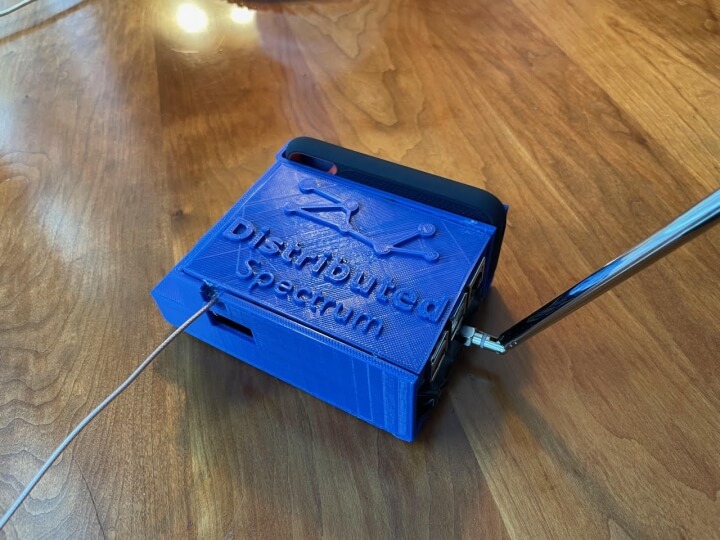Seniors Alex Wulff, Isaac Struhl and Ben Harpe formed Distributed Spectrum in August 2020. The start-up has since won a number of grants from the United States Department of Defense and National Science Foundation. (Credit: Courtesy of Isaac Struhl)
For Alex Wulff, it started as a cool idea for a senior thesis. Wulff, a senior concentrating in electrical engineering at the Harvard John A. Paulson School of Engineering and Applied Sciences (SEAS), wanted to know the combined capabilities of low-cost, commercially available radio frequency monitors when set up as a network.
Wulff’s plans changed during the pandemic. He, along with fellow seniors Isaac Struhl and Ben Harpe, both studying computer science at SEAS, decided to take a year off and try to build a company around Wulff’s low-cost radio spectrum monitoring technology.
Their goal: develop sensors and a software package that can identify whether a radio signal is disrupting communications in a localized area, classify whether the signal should or shouldn’t be there, and then localize the source of the signal.
“Alex is basically a radio guru,” Struhl said. “Especially early on, Alex and I had handheld transceivers, which are basically walkie-talkies. We set up a few of our sensors, and literally walked around town transmitting and gathering data. We walked around for 4-5 hours for a couple days, gathered all the data and started implementing our ideas.”
Out of these experiments, the seniors formed the start-up Distributed Spectrum, which has received funding from a series of government grants.
In February 2021, Distributed Spectrum won the $25,000 grand prize at “Mad Hacks: Fury Code,” a start-up competition organized by the National Security Innovation Network, which connects the United States Department of Defense with American colleges and universities. A strong presentation at Vector, another NSIN showcase, earned Distributed Spectrum another $25,000 in June, but the big prize came at the end of 2021.
The trio was approved for a Small Business Innovation Research grant of nearly $250,000 from the National Science Foundation, which will provide enough funding to keep the company going post-graduation and hopefully pave the way for bringing a product to market.
“It’s a great way for us to have the funding to run all these experiments and really figure out if this is going to work or not, and that’s what the NSF is interested in,” Harpe said. “Their whole goal is to enable cool start-ups to play around and experiment and see if this can actually become a thing.”
“Our more general thesis as a company is to develop this modular, hardware-agnostic software platform that would allow any end-user to say, ‘We need to know about anybody trying to jam given communications or navigation frequencies.’” Wulff said.
The technology has both national security and industrial applications. For example, deployed soldiers sometimes lose communication capabilities while driving in tanks, but have no way to safely determine why.
“The problem could be just some hardware malfunction, and you have to go screw in a bolt and then it’s fine,” Struhl said. “Or it could be you’re subject to an electromagnetic attack, and if it’s the latter, the last thing you want to do is get out of your vehicle and move around on top of it. You only need one sensor to say, ‘Hey, this signal is being jammed.’”
Distributed Spectrum sensors monitor the radio spectrum and can identify if a frequency is disrupting communications, classify if the frequency is abnormal, and then network with a sensor array to localize the source of the frequency. (Credit: Courtesy of Isaac Struhl)
That ability to identify a cyberattack was enough to interest the Department of Defense, which offered Distributed Spectrum a subcontract with the U.S. Air Force.
The SBIR grant enables the trio to see just how effective their technology is at localizing radio signals. One sensor can determine if a signal is there, but finding out where it’s coming from will take a sensor network, which they can now build on a large scale.
“To do state-of-the-art localization of a transmitter, you need to have really precise calibrated clocks,” Struhl said. “You can measure the time it takes a signal to get to each sensor and then triangulate, but the problem is light travels really fast, on the order of 1 foot per nanosecond. So if these sensors have their clocks off by a millisecond, your estimate is going to be off by up to a million feet.”
When they arrived at Harvard as freshmen, none of the seniors knew this would be the direction their education would take them. Now with just one semester left at SEAS, Wulff, Struhl and Harpe are hoping to keep Distributed Spectrum going for years to come.
“Coming into freshman year, I wanted to learn about computer science, and I thought programming was a skill I wanted to learn,” Harpe said. “But I certainly had no entrepreneurial ambitions back then, and it really just came over the course of taking courses, doing extracurriculars at Harvard, and learning about the types of work and types of problems that I really liked to solve. And then the pandemic just provided a really natural time for the three of us to say this made sense to give it a shot.”

